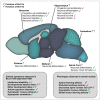The Role of Bcl11 Transcription Factors in Neurodevelopmental Disorders
- PMID: 38392344
- PMCID: PMC10886639
- DOI: 10.3390/biology13020126
The Role of Bcl11 Transcription Factors in Neurodevelopmental Disorders
Abstract
Neurodevelopmental disorders (NDDs) comprise a diverse group of diseases, including developmental delay, autism spectrum disorder (ASD), intellectual disability (ID), and attention-deficit/hyperactivity disorder (ADHD). NDDs are caused by aberrant brain development due to genetic and environmental factors. To establish specific and curative therapeutic approaches, it is indispensable to gain precise mechanistic insight into the cellular and molecular pathogenesis of NDDs. Mutations of BCL11A and BCL11B, two closely related, ultra-conserved zinc-finger transcription factors, were recently reported to be associated with NDDs, including developmental delay, ASD, and ID, as well as morphogenic defects such as cerebellar hypoplasia. In mice, Bcl11 transcription factors are well known to orchestrate various cellular processes during brain development, for example, neural progenitor cell proliferation, neuronal migration, and the differentiation as well as integration of neurons into functional circuits. Developmental defects observed in both, mice and humans display striking similarities, suggesting Bcl11 knockout mice provide excellent models for analyzing human disease. This review offers a comprehensive overview of the cellular and molecular functions of Bcl11a and b and links experimental research to the corresponding NDDs observed in humans. Moreover, it outlines trajectories for future translational research that may help to better understand the molecular basis of Bcl11-dependent NDDs as well as to conceive disease-specific therapeutic approaches.
Keywords: Bcl11a; Bcl11b; Ctip1; Ctip2; brain development; disease modeling; neurodevelopment; neurodevelopmental disorders; transcription factor.
Conflict of interest statement
The authors declare no conflicts of interest.
Figures


References
-
- Sydnor V.J., Larsen B., Bassett D.S., Alexander-Bloch A., Fair D.A., Liston C., Mackey A.P., Milham M.P., Pines A., Roalf D.R., et al. Neurodevelopment of the association cortices: Patterns, mechanisms, and implications for psychopathology. Neuron. 2021;109:2820–2846. doi: 10.1016/j.neuron.2021.06.016. - DOI - PMC - PubMed
-
- World Health Organization . International Statistical Classification of Diseases and Related Health Problems. 11th ed. Volume ICD-11 World Health Organization; Geneva, Switzerland: 2019.
Publication types
Grants and funding
LinkOut - more resources
Full Text Sources

